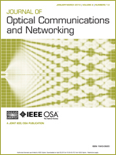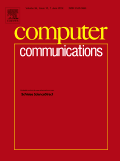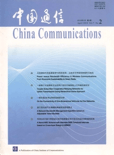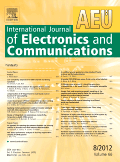
WIRELESS PERSONAL COMMUNICATIONS
Scope & Guideline
Pioneering Research in Personal Wireless Technologies
Introduction
Aims and Scopes
- Wireless Communication Technologies:
The journal covers a broad spectrum of wireless communication technologies, including 5G, IoT, MIMO, and cognitive radio systems, exploring advancements and their implications for future wireless networks. - Network Security and Privacy:
Research on security protocols, encryption techniques, and privacy-preserving methods in wireless networks is a significant focus, addressing vulnerabilities and enhancing the robustness of communication systems. - Energy Efficiency and Optimization:
Papers often address energy-efficient communication strategies, resource allocation algorithms, and optimization techniques aimed at reducing energy consumption in wireless networks. - Signal Processing Techniques:
The journal highlights advancements in signal processing methodologies applied to wireless communication, including channel estimation, modulation schemes, and interference management. - Applications in Healthcare and Smart Cities:
Research exploring the integration of wireless communication technologies in healthcare systems and smart city applications is also emphasized, showcasing practical implementations and benefits.
Trending and Emerging
- Machine Learning Applications:
There is a growing trend towards applying machine learning techniques in various aspects of wireless communications, including network optimization, intrusion detection, and signal processing. - Physical Layer Security:
Research focusing on enhancing physical layer security through advanced techniques, such as the use of reconfigurable intelligent surfaces (RIS), is gaining traction, highlighting the importance of secure communications. - Energy Harvesting Technologies:
An emerging focus is on energy harvesting for sustainable wireless communication, with research exploring innovative methods to power devices in energy-constrained environments. - Integration of Wireless Technologies with IoT:
The convergence of wireless communication technologies with IoT applications is a prominent theme, emphasizing the development of smart systems for healthcare, agriculture, and urban management. - Advanced Signal Processing Techniques:
Emerging research on advanced signal processing methods, including deep learning for signal detection and estimation, is becoming increasingly popular, driving innovation in the field.
Declining or Waning
- Traditional Wireless Technologies:
As the focus shifts towards advanced technologies like 5G and IoT, traditional wireless communication technologies (e.g., 2G, 3G) are being explored less frequently, reflecting the industry's move towards newer paradigms. - Basic Routing Protocols:
There is a noticeable decline in research related to basic routing protocols for traditional wireless networks, as more complex and adaptive routing strategies become the focus of new studies. - Simple Security Protocols:
The journal has seen a decrease in submissions regarding basic security protocols, as researchers now prioritize more sophisticated, multi-layered security frameworks that address contemporary threats.
Similar Journals

Frontiers in Communications and Networks
Fostering Collaboration in Evolving Digital LandscapesFrontiers in Communications and Networks is a prominent open-access journal published by FRONTIERS MEDIA SA, established in 2020 and positioned in the heart of Switzerland. As an interdisciplinary platform, it focuses on advancing research related to computer networks, communications, and signal processing, providing a critical forum for innovative findings and developments in these rapidly evolving fields. With an impressive Q1 ranking in Computer Networks and Communications and a Q2 ranking in Signal Processing as of 2023, this journal is highly regarded among scholars and practitioners seeking to disseminate their work to a broad audience. By offering open-access options, it ensures that the research is widely available, fostering collaboration and knowledge sharing across the globe. Researchers, professionals, and students are encouraged to engage with the journal as it aims to encapsulate the burgeoning advancements shaping our digital communication landscape.

Journal of Optical Communications and Networking
Connecting Ideas, Inspiring DiscoveriesJournal of Optical Communications and Networking, published by Optica Publishing Group, stands at the forefront of research in the rapidly evolving field of optical communication and networking. With an impressive 2023 Q1 ranking in Computer Networks and Communications and a notable Scopus ranking of #53 out of 395, this journal serves as a vital resource for academics and professionals keen on exploring innovative solutions and emerging technologies. Operating under the ISSN 1943-0620 and E-ISSN 1943-0639, it publishes high-quality, peer-reviewed articles that span a wide range of topics from theoretical insights to practical applications in optical systems. As an Open Access publication, it ensures global dissemination of knowledge, allowing researchers and enthusiasts alike to contribute to and access cutting-edge findings. Since its inception in 2009, the journal has fostered a collaborative platform for authors and readers, stimulating advancements in the interconnected domains of optical communications and networking through 2024 and beyond.

IEEE Open Journal of the Communications Society
Advancing the Frontiers of Communication ResearchWelcome to the IEEE Open Journal of the Communications Society, a premier open-access publication dedicated to advancing the fields of computer networks and communications. Launched in 2020 by the esteemed IEEE-Institute of Electrical and Electronics Engineers, this journal operates under a commitment to disseminate high-quality, peer-reviewed research that fosters innovation and collaboration within the global communications community. With an impressive impact factor and currently positioned in the Q1 category of Time's rankings for Computer Networks and Communications (2023), the journal ranks 21st out of 395 in its field, placing it within the top 6% globally. It serves as a vital forum for researchers, professionals, and students, providing them with immediate access to pioneering studies and emerging trends. Being fully open access, all published articles are freely available to enhance the reach and impact of your research. Join us in exploring transformative ideas and technologies that shape the future of communications.

TELECOMMUNICATION SYSTEMS
Elevating Knowledge in Electrical and Electronic EngineeringTelecommunication Systems is a premier academic journal published by Springer, dedicated to advancing the field of telecommunications and information systems. With an ISSN of 1018-4864 and an E-ISSN of 1572-9451, this journal has established itself as a crucial resource in the realms of Electrical and Electronic Engineering, evidenced by its esteemed ranking in the Q2 category and a 70th percentile standing in Scopus ranks. Since its inception in 1993, it has provided an important platform for original research, innovative solutions, and theoretical developments in telecommunications technologies. The journal's objectives include fostering interdisciplinary collaboration and exploring the latest advancements in communication systems, making it essential reading for researchers, professionals, and students alike. With its commitment to quality and relevance, Telecommunication Systems remains at the forefront of scholarly communication in the dynamic telecommunications sector.

EURASIP Journal on Advances in Signal Processing
Fostering Knowledge Exchange in Signal Processing Technologies.EURASIP Journal on Advances in Signal Processing, published by Springer, is a premier open-access journal that has been at the forefront of research in the field of signal processing since its inception in 2001. With a focus on advancing the disciplines of Electrical Engineering, Hardware and Architecture, and Signal Processing, this journal plays a crucial role in disseminating innovative findings and facilitating collaboration among academics and industry professionals. Ranking in Q2 for Electrical and Electronic Engineering and Q3 in both Hardware and Architecture and Signal Processing as per the 2023 category quartiles, it highlights the journal's commitment to high-quality research. The journal is indexed in Scopus, reflecting its reputable standing within the global research community. Researchers, professionals, and students are invited to contribute to and benefit from the wealth of knowledge and advancements presented in each issue, furthering their understanding and application of state-of-the-art signal processing techniques.

IEEE Internet of Things Journal
Charting New Territories in Connected TechnologiesWelcome to the IEEE Internet of Things Journal, a leading publication in the field of connected systems and smart technologies. Published by the IEEE - Institute of Electrical and Electronics Engineers Inc, this journal is dedicated to disseminating cutting-edge research and innovative developments in the Internet of Things (IoT) domain. With an impressive impact factor and recognized as a Q1 journal across multiple categories such as Computer Networks and Communications, Information Systems, and Signal Processing, the IEEE Internet of Things Journal serves as an essential resource for researchers, industry professionals, and students looking to advance their knowledge and contribute to this rapidly evolving field. Since its inception in 2014, the journal has steadily risen to prominence, ranking impressively in Scopus metrics with top positions in key categories, ensuring high visibility and credibility in the academic community. We invite you to explore the rich array of articles and access options available to support your research endeavors in one of the most transformative areas of technology today.

COMPUTER COMMUNICATIONS
Driving Excellence in Networking ResearchCOMPUTER COMMUNICATIONS is a premier journal published by Elsevier, covering cutting-edge research in the field of computer networks and communications. With an impressive 2023 Scopus ranking placing it in the 95th percentile and classified as Q1 in its category, this journal embodies the forefront of technological advancement and scholarly excellence. Since its inception in 1978 and poised to continue until 2024, COMPUTER COMMUNICATIONS serves as an essential platform for disseminating high-impact research that advances our understanding of computer networking protocols, architectures, and applications. Although it is not an open-access publication, the journal provides various access options to ensure that its findings are widely circulated among researchers, professionals, and students. Through rigorous peer review and a commitment to fostering innovation, COMPUTER COMMUNICATIONS plays a vital role in shaping the future of communication technologies.

China Communications
Shaping the Future of Telecommunications through Quality ResearchChina Communications is a prestigious peer-reviewed journal published by the China Institute of Communications, dedicated to advancing the field of telecommunications and information technology. With an impressive Q1 ranking in both Computer Networks and Communications and Electrical and Electronic Engineering, this journal stands out as a leading source of cutting-edge research and innovative solutions in the engineering domain. The journal aims to provide a platform for scholars and practitioners to share their findings on the latest trends, technologies, and methodologies impacting the communications landscape in China and beyond. It is particularly noted for its high visibility in the academic community, as demonstrated by its Scopus rankings, which place it in the top percentiles for both fields. Through its commitment to quality content, China Communications contributes significantly to the advancement of knowledge, making it an invaluable resource for researchers, professionals, and students alike.

AEU-INTERNATIONAL JOURNAL OF ELECTRONICS AND COMMUNICATIONS
Bridging Gaps with Cutting-Edge Research.AEU - International Journal of Electronics and Communications, published by Elsevier GmbH, is a leading peer-reviewed journal that has become an essential resource for scholars and professionals in the fields of electronic communications and electrical engineering. With an impressive impact factor reflective of its rigorous scholarship, the journal holds a Q2 ranking in the category of Electrical and Electronic Engineering, placing it in the top tier of its field. This journal primarily focuses on publishing innovative research, reviews, and advancements that facilitate the convergence of electronics and communication technologies. As it strides through various converged years, from 2001 to 2024, AEU delivers critical insights and cutting-edge developments to a global audience, encouraging collaboration among researchers and practitioners. With its accessible platform, researchers are invited to contribute their findings and to stay abreast of the latest trends and discoveries in this dynamic field, strengthening the journal’s vital role in shaping the future of electronics and communications.

ICT Express
Fostering Global Collaboration in Computational SciencesICT Express is a leading open-access journal published by Elsevier that has established itself at the forefront of the fields of Artificial Intelligence, Computer Networks and Communications, Hardware and Architecture, Information Systems, and Software. Since its inception in 2015, this South Korea-based journal has provided a vital platform for disseminating innovative research and practical applications across these rapidly evolving domains. With an impressive impact factor and consistently high Scopus rankings—placing it in the top quartiles of its categories—it attracts contributions from both seasoned experts and emerging scholars. Current access options ensure that groundbreaking findings are readily available to a global audience, thus fostering collaboration and advancement in technology and computational sciences. As ICT continues to reshape various industries, the significance of research published in ICT Express is crucial for staying ahead in the digital landscape.